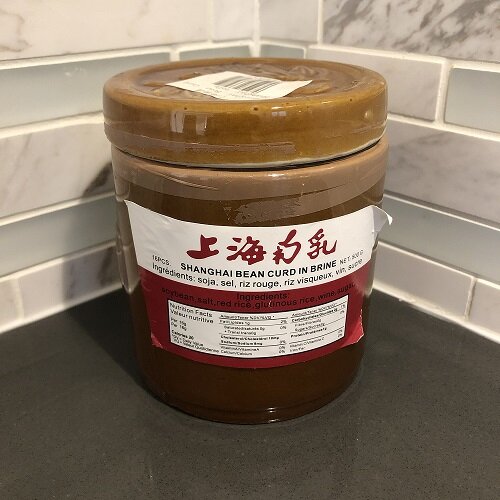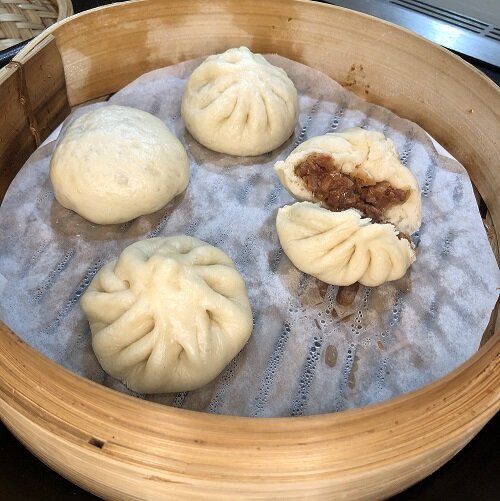Char Siu Bao
Char Siu Bao (叉燒包) is the iconic dish at the dim sum restaurant that is a must-order for our family. The benefit of learning how to make it at home is that you know exactly what was put inside and that alone makes it an even better snack, breakfast, or lunch! Yes, you can make a big batch, freeze them, and reheat quickly using a steamer or microwave.
I teach an online cooking class for this dish Char Siu Bao if you are interested in learning how to make this in a virtual classroom setting using Zoom.
That moment when you open the lid to a freshly steaming basket of bao is pure culinary happiness.
A few extra tips on the recipe:
The key to a delicious and juicy char siu bao is of course in the char siu itself. You could use store-bought or make it yourself. Regardless, you want to have some fat in the meat. If you are lucky enough to live near a Chinese BBQ shop, ask for a cut that is 50/50, meaning half lean half fat. Likewise, if you are making your own, also choose a piece of pork shoulder butt that has quite a bit of fat in it. You won’t regret this.
You may have noticed that both store bought char siu and char siu bao has a reddish hue to it. A lot of recipes and restaurants use food coloring to achieve that look these days. But traditionally, it came about because of a key ingredient used in the marinade: Red Fermented Bean Curd, 南乳. It has many translated names: Shanghai Bean Curd in Brine, or simply Red Bean Curd. They are all the same thing. The red color came from adding red rice during the fermentation process. It also creates a sweeter and deeper flavor than the plain fermented bean curd 腐乳 which has a pale beige color to it.
Shanghai or red bean curd is all the same thing. More traditional brands are sold in a ceramic jar like this but not all of them are.
Typically in dim sum restaurants, shallots are not added to the char siu bao filling. But I find it adds a pop of sweetness and juiciness in the homemade version that is quite nice. It is entirely optional though.
If you are nervous about pleating the bao, just know that you could just pinch it close and flip it over with the seam side down for steaming. You will get an equally delicious bao without learning how to pleat!
Another key technique to create the perfect bao is the steaming process. You do need to use a steaming basket - bamboo or stainless steel - so the steam could pass freely through the bao during the cooking process. You also definitely need to line the basket with parchment paper so they don’t stick to the basket. Never overcrowd your basket too as the buns do expand. Last but not least, bao doesn’t like the sudden change in temperature so this is why you put the bao in the steamer before the water gets hot, and you let it sit for 5 min after steaming before you open the lid. If you miss these 2 steps, your bao will not have the perfect shape it’s destined to have.
The double basket is almost a necessity to this recipe because you don’t want to regret by making too few of these at a time!
Char Siu Bao 叉燒包
Prep to Serve: 2 hours
Cleanup: some work
Freezes well
Makes 10 bao
Must have ingredients for the dough:
Active dry yeast, 3/4 tsp
Sugar, 1 tsp
Warm water, 3/4 cup (105-110F, or 40C)
Flour, 280 g (~2.5 cups)
Must have ingredients for the filling:
Char siu, 1.5 cup (cooked, finely chopped)
Shallots (small), 3 (finely chopped)
Red bean curd or Shanghai bean curd or Fermented red bean curd, 1.5 tablespoons
Honey, 1.5 tablespoons
Light soy sauce, 1/2 teaspoon
Chinese (Shaohsing) rice wine, 1/2 teaspoon
Steps:
Dissolve yeast and sugar in warm water. Wait 10 minutes for the yeast to activate and foam up. Stir in flour, reserving 1/4 cup for kneading, until it comes together into a dough. Knead in the bowl until smooth and not sticky. Cover dough with a damp towel to proof in a warm place for 1 hour.
Meanwhile, finely chop char siu and shallots. Set aside separately.
Mix fermented red bean curd, honey, light soy and rice cooking wine in a small bowl.
In a small pan over medium heat, lightly fry shallots in a splash of cooking oil until translucent, then add char siu to stir fry for a minute before adding the sauce. Cook until the sauce has reduced and thickened somewhat, about 2 minutes. Put meat mixture in a bowl to cool down in an ice bath or fridge.
The dough should be ready now. Flour your work surface with the remaining 1/4 cup flour, and knead dough for a few minutes to remove air pockets. Divide into 10 equal parts. Roll each part into a round circle ( about 4 inches in diameter) with thinner edges than the core. The core should be about 2 inches in diameter and double the thickness (about 1/8-inch) than the edges (about 1/16-inch).
Put 2 tablespoons of filling in center of a circle of dough. Pleat along the edges to close the bao. Or simply pinch to seal the dough and flip over with seam-side down. Arrange the buns in a bamboo steamer lined with parchment paper, leaving space in between. Cover and rest for 15 minutes.
Put 2 cups of cold tap water into a wok or large pot with the steamer on top. Over medium-high heat, steam the bao for 15 minutes, starting the timer from cold water. The water should start boiling halfway through. After 15 minutes, turn off the heat and let buns sit for 5 minutes before opening the lid. Serve hot right away or cool and freeze.
To reheat from fridge or freezer, steam buns again for 5 to 8 minutes, respectively. Or wrap the bao in a wet kitchen napkin and microwave for 30-second intervals until soft.
Hope you find this recipe helpful and would give it a try at home. If you enjoyed this recipe and would like to support Dash of Soy, you can send a gift , or Venmo. 100% of your contribution goes into recipe curation, testing, artwork, and our free live cooking shows that make Dash of Soy a special place. Thank you!


